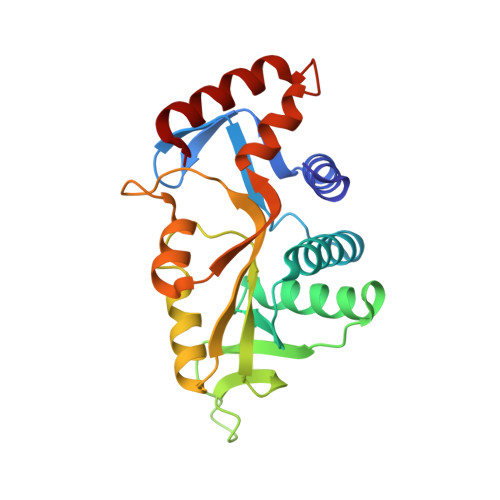A flexible loop at the dimer interface is a part of the active site of the adjacent monomer of Escherichia coli orotate phosphoribosyltransferase.
Henriksen, A., Aghajari, N., Jensen, K.F., Gajhede, M.(1996) Biochemistry 35: 3803-3809
- PubMed: 8620002
- DOI: https://doi.org/10.1021/bi952226y
- Primary Citation of Related Structures:
1ORO - PubMed Abstract:
Orotate phosphoribosyltransferase (OPRTase) is involved in the biosynthesis of pyrimidine nucleotides. Alpha-D-ribosyldiphosphate 5-phosphate (PRPP) and orotate are utilized to form pyrophosphate and orotidine 5'-monophosphate (OMP) in the presence of divalent cations, preferably Mg2+. OMP is thereafter converted to uridine 5'-monophosphate by OMP decarboxylase. We have determined the 2.4 angstrom structure of Escherichia coli OPRTase, ligated with sulfate, by molecular replacement and refined the structure to an R-factor of 18.3% for all data. In the structure of the E. coli enzyme we have determined the fold of a flexible loop region with a highly conserved amino acid sequence among OPRTases, a region known to take part in catalysis. The structure of this region was not determined in the model used for molecular replacement, and it involves interactions at the dimer interface through a bound sulfate ion. Crystalline E. coli OPRTase is a homodimer, with sulfate ions inhibiting enzyme activity bound in the dimer interface close to the flexible loop region. Although this loop is very close in space to the sulfate binding site, and sulfate is found in both interfaces of the homodimer, the loop structure is only traceable in one monomer. We expect that the mobility of this loop is important for catalysis, and, on the basis of the reported structure and the structure of Salmonella typhimurium OPRTase.OMP, we propose that the movement of this loop in association with the movement of OMP is vital to catalysis. Apart from the flexible loop region and a solvent-exposed loop (residues 158-164), the most significant differences in structure between S. typhimurium OPRTase.OMP and E. coli OPRTase are found in the substrate binding regions: the 5'-phosphate binding region (residues 120-131), the binding region for the orotate part of OMP (residues 25-27), and the pyrophosphate binding region (residues 71-73).
Organizational Affiliation:
Center for Crystallographic Studies, University of Copenhagen, København, Denmark.















